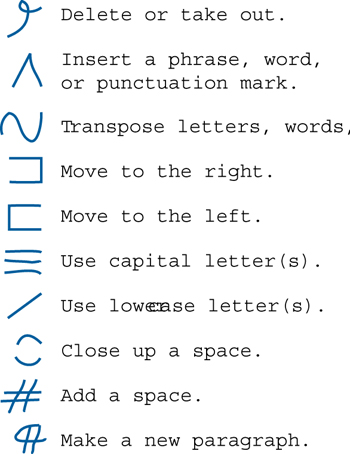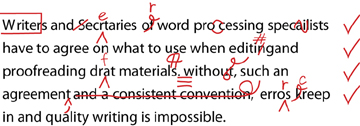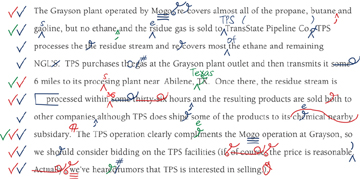- Cliches
- Colons
- Color
- Commas
- Compound Words
- Conjunctions
- Contractions
- Dashes
- Decimals
- Editing and Proofreading
- Electronic Mail
Editing and Proofreading
Anyone who works with documents must have a system for indicating changes to text. Much editing and proofreading is now done on a computer screen, and your software program has those capabilities. But because screen resolution is typically one third or so less than print, it’s wise to proofread printed text to catch errors difficult to see on a screen. The following rules apply mostly to proofreading hard copies of documents. You will also find suggestions for proofreading onscreen.
Standard editing and proofreading symbols (listed in most dictionaries) are more numerous and complex than most of us need unless we are copy editors, typesetters, or printers.
A simplified set of editing and proofreading symbols listed in rule 1 addresses the needs of most business and technical writers who must communicate suggestions and editorial corrections to others. If you need the complete set of proofreading symbols, see the most recent editions of The Chicago Manual of Style or the United States Government Printing Office Style Manual.
The example under rule 1 illustrates the simplified method of editing and proofreading printed text. This example also follows the rules cited below.
Use consistent proofreading symbols to indicate changes or corrections to text:

Original
Corrected
Writers and secretaries or word processing specialists have to agree on what symbols to use when editing and proofreading draft materials.
Without such an agreement, errors creep in and quality writing is impossible.
NOTE 1: Professional proofreaders sometimes use a different symbol in the margin than they use in the text. For instance, the # sign in the margin indicates that a space should be added. In text, a slash mark indicates where the space should be added:

NOTE 2: Some reviewers also use the symbol sp in the margin to indicate a spelling error.
Use marginal marks to indicate corrections made within lines.
Changes to a text are sometimes difficult to see, particularly those changes made in pencil or black ink, which readers may have trouble distinguishing from surrounding print. To highlight changes or corrections, you should use a red or green pencil or pen for changes. Even the change in color is sometimes difficult to see, however, particularly for color-blind reviewers.
So indicate changes by marking the change within the text but also inserting a check mark to show that a change appears in the text beside the mark.
Be consistent in using these standard proofreading symbols.
Use different colors of ink for different proofreadings (either by the same person or several people).
Printed text going through multiple revisions can become difficult to decipher if readers can’t distinguish between versions. A very good system is to change the color of the reviewer’s or proofreader’s pencil or pen (as in the example below).
The first reviewer might indicate changes in blue ink, the second in red, the third in green, and so on. The color of the suggestion thus indicates when and by whom the suggestion was made. This system is particularly effective during peer or group review.
Keep a list of editorial or proofreading decisions so you can be consistent and so you can summarize for the writer the changes you routinely make.
The list of editorial or proofreading decisions is sometimes called an editorial style sheet. Writers themselves sometimes develop it, or they wait for an editor or a proofreader to develop one. The earlier it can be developed, the better. Your software program can be set to follow your rules so you don’t have to track these decisions.
Items on this list would include all decisions about punctuation, capitalization, spelling, or word usage. To illustrate, a proofreader working with the preceding example could make these sorts of decisions:
- Grayson plant (not Grayson Plant)
- MOGO (not Mogo)
An Example of Multiple Proofreadings
- Comma in a series precedes and: propane, butane, and gasoline
- TransState Pipeline Co. (not Company)
- TPS (TransState Pipeline Co.) rather than TransState Pipeline Co. (TPS)
When proofreading on a computer screen, use the feature that records and tracks changes so others can see your suggestions. You can find this feature in the review or revision menu of your software program. Once activated, the computer marks changes you make in the document. You can also indicate which changes you want marked. For example, you can order the computer to underline insertions, strike through deletions, or bold changes in format. You can also identify which reviser is making these changes.
NOTE: As the above examples suggest, some language decisions about a document are not clearly right or wrong. Instead, an editor or proofreader has to pick the preferred form and then stay with that choice throughout the document. See STYLE and PUNCTUATION.
Follow effective proofreading strategies.
To ensure the effectiveness of your document and to protect your image and your organization’s, you should proofread every important document—even emails if they have significant implications. Documents differ in importance, however, and require different proofreading strategies. See WRITING AND REVISING.
When hurried or faced with a low-priority document, read through the document once, paying special attention to important points such as headings, topic sentences of paragraphs, visuals, and captions.
For more important documents, consider some of these proofreading strategies:
- Check format. Does the document look good—with uniform spacing, heading styles, and lists? Are emphasis techniques (boldface, italics, etc.) consistently applied?
- Check content. Is the information correct? For example, if the invitation says the meeting is on Monday, June 15, will the meeting actually take place then? And does June 15 really fall on a Monday? Are figures such as monetary amounts or percentages correct? Do you find facts contradicted from one page to another?
- Check for errors. Double-check spelling of names. Question every capitalization, punctuation, and word division. Note that typographical errors often occur in groups. Question every number and add up figures to make sure sums are accurate.
When proofreading onscreen:
- Magnify the text so you can spot problems that would otherwise go unnoticed. Enlarge the text to 150 percent or whatever suits you.
- Correct errors flagged by spell check and grammar check. Do not rely on these features to find every error. Although a spell check will flag spellings it does not recognize, you must often decide if words are spelled correctly for the context (for example, their vs. there). Even advanced grammar checking software can be wrong. If it flags a sentence as a fragment, for example, refer to this Style Guide for help in deciding if the sentence truly is a fragment or not.
- Turn on hidden formatting symbols such as paragraph and space marks so you can see if the spacing between lines and words is proper.
For particularly important documents, consider these strategies:
- Read backwards so the content does not distract you from watching for errors.
- Read aloud so you slow your reading speed and are more alert to flaws in grammar and sense.
- Read in groups. For long, complex documents, some readers can mark changes on the text or look up words or facts while another reads aloud. In this way, you get more than one viewpoint and speed up the work.


